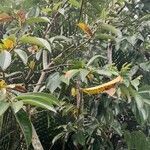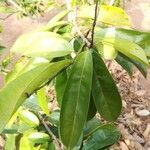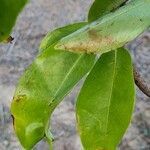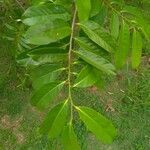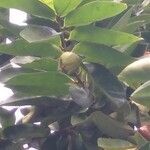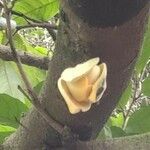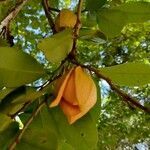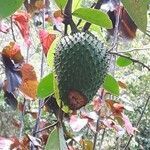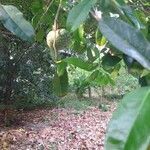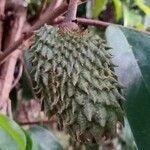Tree to 8 m high. Shoots pubescent. Axillary buds narrowly conical, acute. Leaves: petiole 3–7 mm long; lamina obovate to elliptic, 8–15 cm long, 3–6 cm wide, acute to rounded at base, acuminate at apex, glabrous above, sparsely pubescent beneath; secondary veins 8–12 pairs; domatia in some vein axils. Flowers solitary, terminal or leaf-opposed; pedicel 1.5–2 cm long, pubescent. Sepals depressed-ovate, 3–4 mm long. Petals 6, similar, broadly ovate, greenish yellow. Outer petals ovate, acuminate or acute at apex, cordate at base, 2–4 cm long, 2–3.5 cm wide, medially ridged, sparsely pubescent outside, densely puberulous inside. Inner petals ovate, 1.8–3.2 cm long, obtuse, puberulous, shortly clawed. Stamens 4–5 mm long. Carpels free at anthesis. Syncarpium ovoid, 10–25 cm long, 12–15 cm wide, with soft, curved spines 6 mm long, dark green. Seeds 15–17 mm long, 9–10 mm wide. See also Du Puy (1993: 64).
It is a low bushy tree 8-10 m high. The leaves are long (14 cm) and narrow (4 cm). The leaves are thick and slightly shiny on top. The flowers are large (2-3 cm), rounded and produced on short stems on the branches. They occur singly, or in groups of three. The flowers have two layers of thick fleshy petals. The fruit are 10-30 cm long. The fruit is spiny and the flesh is juicy. Many black seeds are embedded in the white flesh. Fruit are often distorted due to only some of the ovules being fertilised. Beetles are normally thought to do the pollinating. This means fruit end up heart shaped when unevenly pollinated. The flesh of the fruit is white. Several kinds with different sweetness, shape and juiciness occur.
